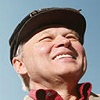17.4: Our own species
- Page ID
- 25530
Figure \(\PageIndex{1}\). One of the most conspicuous mutualisms on the planet involves our species. Our mutualisms are biological, but have become technological as well, with teams of satellite-guided tractors navigating our fields with the power of a thousand horses.
We reached our present numbers through a complex of mutualisms. A variety of increasingly refined crops and increasing domesticated animals acted as mutualists, switching our population dynamics from boom-and-bust predator–prey cycling (Figure \(\PageIndex{2}\)A) to prolonged runaway growth (\(\PageIndex{2}\)B). Through cultivation of plants and animals that were formerly prey, agriculture increased the carrying capacity of the cultivated species, which in turn increased human carrying capacity, forming a positive feedback loop. It may seem dubious to consider domesticated plants and animals as our mutualists, but their parameters meet the mathematical requirements of mutualism. And both populations can expand so rapidly that they would soon exceed all former bounds.
Mutualisms in nature typically do not long follow the unrestrained growth toward astronomical levels shown in Figure \(\PageIndex{2}\)B. Instead, natural mutualisms increase only until they are checked by some other force, such as predators or disease. Our ancestors, however, kept their mutualisms pure by eliminating third-species interferences. They hunted and killed predators of domesticated animals, weeded crops to eliminate plant competitors, and fenced crops to exclude herbivores. Indeed, the human species does not now dominate the earth, as often suggested. The mutualisms dominate. The joint biomass of cows, horses, pigs, chickens, and dogs exceeds the biomass of humans, to say nothing of the biomass of crops. We did not get here alone.
We have recently outgrown the need for animal mutualists to power plows and support locomotion, substituting engines consuming fossil fuels instead. These are like synthetic mutualists. We also outgrew the need for animals to fertilize crops, substituting artificial nitrogen fertilizer created in Haber–Bosch process furnaces from the vast supply of nitrogen in the air. The need for animals and plants for clothing diminished with synthetic cloth and furs. All of these brought us to a partially non-biological world, still developing, where not even the carrying capacities of our living mutualists need be limiting.
However, advancing medicine and public health eventually decreased child mortality. Death rates fell and, later, birth rates began to fall even faster. The mutualisms remain, but—unexpectedly and abruptly— twelve millennia of rapidly accelerating population growth ended (Figures 6.3, \(\PageIndex{2}\)C).
As a closing note, in the twenty-first century, after only about fifty years of decelerating growth, the global population continues to increase. But, births in many societies have dropped below replacement levels in a final stage characterized by declines in the resident populations, compensated in many countries by immigration. The relative rapidity of this change may spill over into social disjunction between conditions of the present and memories of times past. It may also foretell a future time when our species may voluntarily reduce populations to sustainable values yet unknown (dotted lines in Figure \(\PageIndex{2}\)C).


